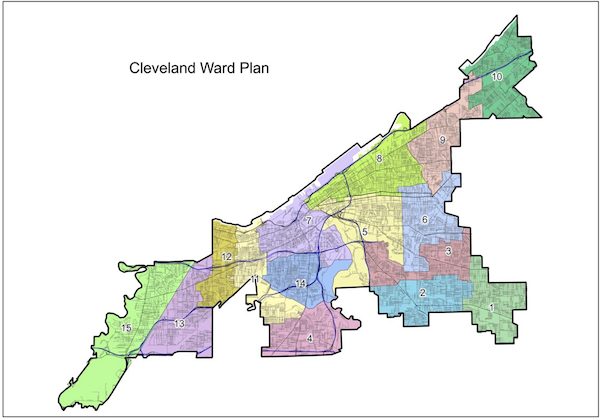
A new political era is coming to Cleveland City Council, courtesy of council’s impending reduction in size, and the brouhaha over whose ox is being gored has totally obscured its fundamental implications for the city’s politics.
When it comes time to redraw electoral boundaries, politicians often insist that their options are restricted by geographic factors like rivers and railroad tracks, constitutional or other legal requirements, and the demands of their legislative colleagues.
While these may all be valid considerations, mapmakers almost always have considerable latitude in how the lines get drawn to favor or punish incumbents or communities.
This was certainly the case regarding the reconfigured ward boundaries that Cleveland City Council is expected to vote on tomorrow.
The next council will have 15 members, down from the current 17. The reduction in council’s size is mandated by the city’s Charter, which ties the number of city wards to the city’s population, as measured by the nation’s decennial census. The city's population dipped below 375,000 in the official count, triggering the need for council reduction.
Council President Blaine Griffin went public with the proposed new ward boundaries in late November after he was called out on the council floor by Ward 12 councilmember Rebecca Maurer, whose district will disappear if the new boundaries are approved by the full council tomorrow night.
In a highly unusual move, Griffin relinquished the gavel, taking the floor to rebut Maurer’s passionate objections in a tone and manner that was both dismissive and sexist. Griffin claimed innocence of any intent on his part to vaporize Maurer from her ward, saying that she like all her colleagues, had to adjust to the city’s population shifts.
Griffin later held a press conference where he trotted out his paid consultants to recite standard pablum about the technical difficulties inherent in redrawing boundaries in a city with a lake, a river, railroad tracks, and assorted peninsulas.
It says here that Griffin intentionally ordered the shredding of Maurer’s district.
How do we know this? The proposed map tells us for one, and so does common sense. But let us first consider what the new map does well.
By uniting the city’s large and historic Collinwood district and eliminating the serpentine district along the city’s eastern lakefront, Griffin’s map repairs the major monstrosities of former president Marty Sweeney’s straightforward abortive attempt to protect his political ally, then-councilman Eugene Miller and punish his political enemy, former councilman [now judge] Jeff Johnson. While Sweeney’s blatant maneuver failed spectacularly, it more significantly distorted political representation in multiple neighborhoods.
This was important to fix, and Griffin deserves credit for making it happen.
In addition to punishing Maurer, the new map also radically reshapes representation for downtown Cleveland and nicely realigns the city’s west side wards.
The city’s core business district, which now has a significant and relatively affluent residential component, will now be represented by two eastside council people.
This will be unprecedented, and it will be consequential. The affected eastside wards are currently represented by Stephanie Howse and Richard Starr. If you ask most people — including Howse and Starr — they would be identified as the representatives of Hough and Central, two of the city’s blackest and most impoverished areas. Councilmembers from those wards will now be called upon to balance the compelling interests of the city’s richest and poorest populations.
How will that play out?
Let me suggest that any councilperson who can successfully navigate that responsibility would become a consequential candidate for higher office.
I wrote above of Griffin’s intent to remove Maurer from council by eviscerating her base. This conclusion is supported by the map. Let’s do the math. Earlier this year, Ward 16’s Jenny Spencer announced she would not run for re-election. The Collinwood unification ostensibly pits the hoary Mike Polensek against the politically ambitious Anthony. Hairston, a near unmistakable signal that Polensek has told Griffin that he is stepping down after his record-length tenure.
Most tellingly, the reassignment of downtown to two eastside incumbents at the expense of sitting councilman Kerry McCormack would be inconceivable if McCormack has not indicated to Griffin that he is exiting council alongside Spencer and Polensek.
So, if three incumbents are leaving, and only two seats must be eliminated, why would Maurer’s ward have to disappear if Griffin didn’t want her gone?
Many variables remain to be resolved before June’s filing deadline, September’s primary, and November’s election. Will Maurer choose to run from a new ward? Will a viable challenger emerge for Deborah Gray, who not only stands to lose Shaker Square [to Griffin] but now looks to have council’s most serpentine-shaped seat? What progressive newcomer[s] will emerge from the city’s recent initiative campaigns?
The resolution of these questions means that a year from now, the new council could be missing as many as five current incumbents, seating at least three new members, facing a significant increase in its gender imbalance, and possibly have its first majority-minority composition.
• • •• • •










